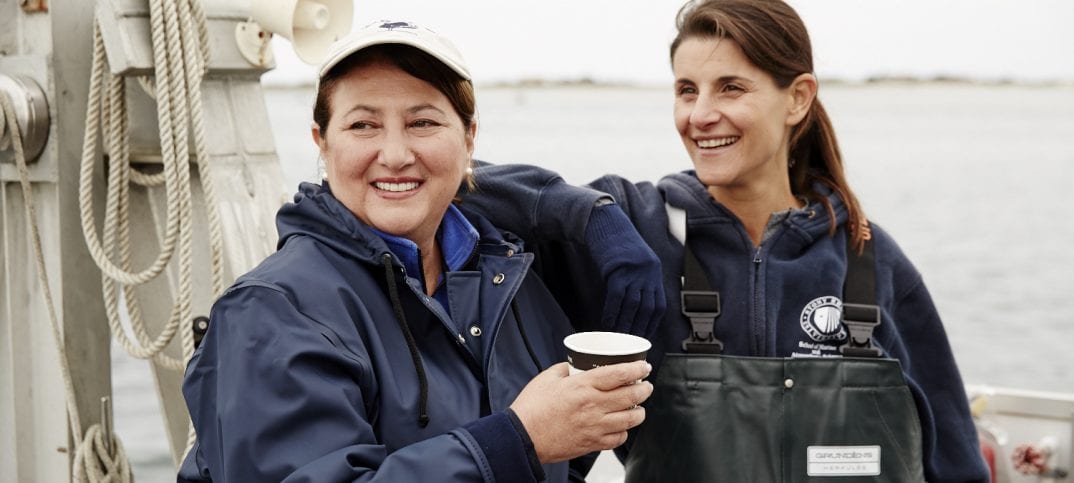By Daniel Dunaief
It’s one thing to make a commitment to a good idea; it’s another to follow through. Ellen Pikitch, endowed professor of ocean conservation science in the School of Marine and Atmospheric Sciences at Stony Brook University, is making sure countries around the world know where and how they can honor their commitment to protect the ocean.
In 2015, the United Nations had agreed to designate at least 10 percent of the oceans as Marine Protected Areas, which would restrict fishing and foster conservation. The goal of the proposal is to reach that figure by next year.
Three years ago, with the support of the Italian Ministry of Environment and private donations, Pikitch started the labor-intensive process of finding ocean regions that countries could protect.

She published the results of her analysis in the journal Frontiers in Marine Science. Her research could help countries move from the current 7.8 percent of oceans protected to the 10 percent target, and beyond that figure in the ensuing years.
The United States has met its target, although most of its marine protected ares are far from human population centers, so the coverage is uneven, Pikitch explained. The rest of the world has some gaps in high priority areas.
“I’m hoping that the study will light a fire under the policymakers so that they do meet their commitment,” said Pikitch. “It’s quite feasible for them to meet the goal. We’ve given [policymakers] advice in this paper about how exactly it could be done.”
The maps in the paper show areas that are within the current jurisdiction that are priority areas and are unprotected.
“There is quite a bit of area that meets this description — more than 9 percent — so there is flexibility in how countries can use the results and reach or exceed” the 10 percent target by next year, Pikitch explained in an email.
To determine where nations can enhance their ocean protection, Pikitch, Assistant Professor Christina Santora at the Institute for Ocean Conservation Science at Stony Brook University and Stony Brook graduate Natasha Gownaris, who is now an assistant professor in environmental studies at Gettysburg College, pulled together information from 10 internationally recognized maps indicating the location of global marine priority areas.
“We are standing on the shoulders of giants, capitalizing or leveraging all the hard work that has gone into other maps,” said Gownaris.
One of the most unexpected findings from the study for Pikitch is that 14 percent of the ocean was considered important by two to seven maps, but over 90 percent of those areas remained unprotected. A relatively small part of this area is on the high seas, while most is within exclusive economic zones, which nations can control.
To preserve this resource that continues to remove carbon dioxide from the atmosphere while serving a critical role in the world’s food chain, conservationists have focused on marine protected areas because they provide the “one thing we felt was going to be the most effective single step,” said Mark Newhouse, the executive vice president for newspapers at Advance Publications and president of the Ocean Sanctuary Alliance. “It could happen overnight. A country could say, ‘This area is off limits to fishing,’ and it is.”
Countries can protect areas within their exclusive economic zones “more quickly than figuring out a way to solve global warming,” Newhouse added.
Santora explained the urgency to take action. “The situation in the ocean is worsening and we can’t wait to have perfect information to act,” Santora wrote in an email. “What we can do is put strong, effectively managed MPAs in the right places, with a high level of protection, that are well managed and enforced.”
Members of the Ocean Sanctuary Alliance, which counts Pikitch as its scientific officer, recognize that the 7.8 percent figure includes areas where countries have announced their intention to protect a region, but that doesn’t necessarily include any enforcement or protection.
“Intentions don’t protect the environment,” Newhouse said.
Ambassadors from several nations have reached out to OSA to discuss the findings.
These diplomats are “exactly the people we want paying attention” to the research Pikitch and her team put together, Newhouse said.
Pikitch also plans to reach out proactively.
According to Pikitch’s recent analysis, the largest gaps in policy coverage occurred in the Caribbean Sea, Madagascar and the southern tip of Africa, the Mediterranean Sea and the Coral Triangle area, although they found additional widespread opportunities as well.
Pikitch calculated that an additional 9.34 percent of areas within exclusive economic zones would join the global marine protected area network if all the unprotected area identified as important by two or more initiatives joined the MPA network.
“When effectively managed, when strong protections are put in place, they work,” Pikitch said.
Indeed, one such example is in Cabo Pulmo, Mexico, where establishing a marine protected area resulted in an 11-fold increase in the biomass of top predators within a decade. Many MPAs become sites for ecotourism, which can bring in hefty sums as people are eager to see the endemic beauty in their travels.
Pikitch hopes this kind of study spreads the word about the benefit of protecting the ocean and that policymakers and private citizens recognize that protecting sensitive regions also benefits fisheries, refuting the notion that environmentally driven policy conflicts with the goal of economic growth.
The groups involved in this study are already discussing the new goal for the ocean. Several diplomats and scientists would like to see the bar raised to 30 percent by 2030, although the United Nations hasn’t committed to this new target yet.
“Studies show that 10 percent is insufficient — it is a starting point,” Santora wrote. “I do think that targets beyond 2020 will increase.”
Pikitch said the ocean has always been one of her passions. Her goal is to “leave the world in better shape than I found it” for her children and six grandchildren.







